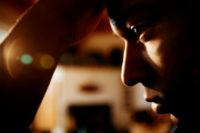Get through the holiday blues

 The holidays aren't joyous for everyone. This time of year can bring stress and feelings of loneliness. Exercise, focusing on positive relationships, and doing things that you find rewarding can help with depression. Get tips on what to do if you feel depressed. Keep in mind that winter depression could be a sign of seasonal affective disorder (SAD), which is caused by the lack of sunlight. Treatment for SAD is much like other forms of depression, but may also involve light therapy.
The holidays aren't joyous for everyone. This time of year can bring stress and feelings of loneliness. Exercise, focusing on positive relationships, and doing things that you find rewarding can help with depression. Get tips on what to do if you feel depressed. Keep in mind that winter depression could be a sign of seasonal affective disorder (SAD), which is caused by the lack of sunlight. Treatment for SAD is much like other forms of depression, but may also involve light therapy.
How can I help myself if I am depressed?
If you have depression, you may feel exhausted, helpless, and hopeless. It may be extremely difficult to take any action to help yourself. But as you begin to recognize your depression and begin treatment, you will start to feel better.
Signs and symptoms of depression
People with depressive illnesses do not all experience the same symptoms. The severity, frequency, and duration of symptoms vary depending on the individual and his or her particular illness.
Signs and symptoms include:
• Persistent sad, anxious, or "empty" feelings
• Feelings of hopelessness or pessimism
• Feelings of guilt, worthlessness, or helplessness
• Irritability, restlessness
• Loss of interest in activities or hobbies once pleasurable, including sex
• Fatigue and decreased energy
• Difficulty concentrating, remembering details, and making decisions
• Insomnia, early-morning wakefulness, or excessive sleeping
• Overeating, or appetite loss
• Thoughts of suicide, suicide attempts
• Aches or pains, headaches, cramps, or digestive problems that do not ease even with treatment.
To Help Yourself
• Do not wait too long to get evaluated or treated. There is research showing the longer one waits, the greater the impairment can be down the road. Try to see a professional as soon as possible.
• Try to be active and exercise. Go to a movie, a ballgame, or another event or activity that you once enjoyed.
• Set realistic goals for yourself.
• Break up large tasks into small ones, set some priorities and do what you can as you can.
• Try to spend time with other people and confide in a trusted friend or relative. Try not to isolate yourself, and let others help you.
• Expect your mood to improve gradually, not immediately. Do not expect to suddenly "snap out of" your depression. Often during treatment for depression, sleep and appetite will begin to improve before your depressed mood lifts.
• Postpone important decisions, such as getting married or divorced or changing jobs, until you feel better. Discuss decisions with others who know you well and have a more objective view of your situation.
• Remember that positive thinking will replace negative thoughts as your depression responds to treatment.
• Continue to educate yourself about depression.
Source; National Institute of Mental Health
Seasonal affective disorder
Seasonal affective disorder (SAD) is a kind of depression that occurs at a certain time of the year, usually in the winter.
Causes, incidence, and risk factors
SAD may begin during the teen years or in adulthood. Like other forms of depression, it occurs more often in women than in men. People who live in places with long winter nights are at greater risk for SAD. A less common form of the disorder involves depression during the summer months.
Symptoms
Symptoms usually build up slowly in the late autumn and winter months. Symptoms are usually the same as with other forms of depression:
• Hopelessness
• Increased appetite with weight gain (weight loss is more common with other forms of depression)
• Increased sleep (too little sleep is more common with other forms of depression)
• Less energy and ability to concentrate
• Loss of interest in work or other activities
• Sluggish movements
• Social withdrawal
• Unhappiness and irritability
SAD can sometimes become long-term depression. Bipolar disorder or thoughts of suicide are also possible.
Signs and tests
There is no test for SAD. Your health care provider can make a diagnosis by asking about your history of symptoms. The health care provider may also perform a physical exam and blood tests to rule out other disorders that are similar to SAD.
Treatment
As with other types of depression, antidepressant medications and talk therapy can be effective.
Managing your depression at home
To manage your symptoms at home:
• Get enough sleep.
• Eat a healthy diet.
• Take medicines the right way. Learn how to manage side effects.
• Learn to watch for early signs that your depression is getting worse. Have a plan if it does get worse.
• Try to exercise more often. Look for activities that make you happy.
• Practice good sleep habits.
Avoid alcohol and illegal drugs. These can make depression worse over time. They may also affect your judgment about suicide.
When you are struggling with depression, talk about how you're feeling to someone you trust. Try to be around people who are caring and positive. Volunteer or get involved in group activities.
Light therapy
Light therapy using a special lamp with a very bright light (10,000 lux) that mimics light from the sun may also be helpful.
• Start treatment during the fall or early winter, before the symptoms of SAD begin.
• Follow your health care provider's instructions about how to use light therapy. A common practice is to sit a couple of feet away from the light box for about 30 minutes every day. This is usually done in the early morning, to mimic sunrise.
• Keep your eyes open, but do not look straight into the light source.
Symptoms of depression should improve within 3 - 4 weeks if light therapy is going to help.
Side effects of light therapy include:
• Eye strain and headache
• Mania, less often (see: Bipolar disorder)
People who take drugs that make them more sensitive to light, such as certain psoriasis drugs, antibiotics, or antipsychotics, should avoid light therapy.
A check-up with your eye doctor is recommended before starting treatment.
With no treatment, symptoms usually get better on their own with the change of seasons. However, symptoms can improve more quickly with treatment.
Expectations (prognosis)
The outcome is usually good with treatment. However, some people have SAD throughout their lives.
Calling your health care provider
Get help right away if you have thoughts of hurting yourself or anyone else.
References
1. American Psychiatric Association. Practice guideline for the treatment of patients with major depressive disorder. 3rd ed. October 2010.
2. Tesar GE. Psychiatry and psychology. In: Carey WD, ed. Cleveland Clinic: Current Clinical Medicine 2010. 2nd ed. Philadelphia, Pa: Saunders Elsevier; 2010: section 11.
Source: U.S. National Library of Medicine
Looking for a reprint of this article?
From high-res PDFs to custom plaques, order your copy today!






